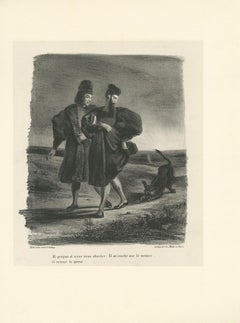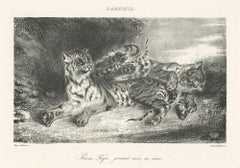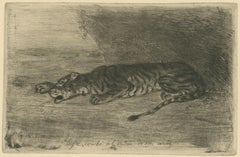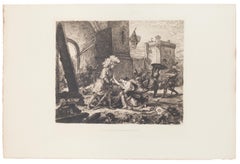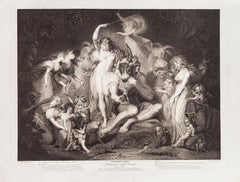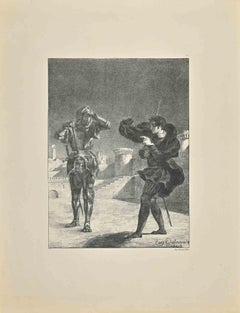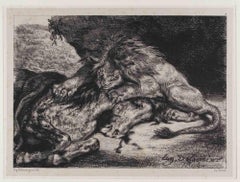Eugene Delacroix Art
French, 1798-1863
Ferdinand Victor Eugène Delacroix (French: 26 April 1798 – 13 August 1863) was a French Romantic artist regarded from the outset of his career as the leader of the French Romantic school.
In contrast to the Neoclassical perfectionism of his chief rival Ingres, Delacroix took for his inspiration the art of Rubens and painters of the Venetian Renaissance, with an attendant emphasis on colour and movement rather than clarity of outline and carefully modelled form. Dramatic and romantic content characterized the central themes of his maturity, and led him not to the classical models of Greek and Roman art, but to travel in North Africa, in search of the exotic. Friend and spiritual heir to Théodore Géricault, Delacroix was also inspired by Lord Byron, with whom he shared a strong identification with the "forces of the sublime", of nature in often violent action.
However, Delacroix was given to neither sentimentality nor bombast, and his Romanticism was that of an individualist. In the words of Baudelaire, "Delacroix was passionately in love with passion, but coldly determined to express passion as clearly as possible."Together with Ingres, Delacroix is considered one of the last old Masters of painting and is one of the few who was ever photographed.
As a painter and muralist, Delacroix's use of expressive brushstrokes and his study of the optical effects of colour profoundly shaped the work of the Impressionists, while his passion for the exotic inspired the artists of the Symbolist movement. A fine lithographer, Delacroix illustrated various works of William Shakespeare, the Scottish author Walter Scott, and the German author Johann Wolfgang von Goethe.(Biography provided by The Stag Gallery)
to
4
1
3
2
4
1
Overall Height
to
Overall Width
to
3
2
2
2
1
1
1
1
1
1
4
1
1
5
6,938
3,292
2,514
1,213
3
3
2
2
1
Artist: Eugene Delacroix
Faust, Méphistophélès et le Barbet / Faust, Méphistophélès and the Water Spaniel
By Eugène Delacroix
Located in Middletown, NY
Lithograph on Chine appliqué, 9 1/4 x 8 1/8 inches (235 x 206 mm), full margins. First state (of 4). Extremely minor uniform age tone, otherwise in good condition. A superb, richly-inked impression.
[Delteil 61.1]
______
At an early age Delacroix became a lover of music and literature and had been drawing from the time he entered school. He expected painting would be a hobby, but on the death of his father he found he had to make his own way in life. In 1817 he entered the studio of Pierre-Narcisse Guerin; amongst his fellow pupils was Gericault. His first exhibited work was Dante and Virgil...
Category
Early 19th Century Barbizon School Eugene Delacroix Art
Materials
Handmade Paper, Lithograph
Jeune Tigre jouant avec sa mère (Young Tiger playing with its mother)
By Eugène Delacroix
Located in Middletown, NY
Lithograph on on white wove paper, 4 1/2 x 7 3/8 inches (112 x 187 mm), wide margins. First state (of 6). A very good impression with minor scattered spots of very light discoloration.
[Delteil 91.1]
__________
At an early age Delacroix became a lover of music and literature and had been drawing from the time he entered school. He expected painting would be a hobby, but on the death of his father he found he had to make his own way in life. In 1817 he entered the studio of Pierre-Narcisse Guerin; amongst his fellow pupils was Gericault. His first exhibited work was Dante and Virgil...
Category
Mid-19th Century Barbizon School Eugene Delacroix Art
Materials
Handmade Paper, Lithograph
Tigre couché à l'entrée de son antre (Tiger Lying at the Entrance to its Lair)
By Eugène Delacroix
Located in Middletown, NY
Etching, drypoint, and roulette on watermarked Hallines cream laid paper, 3 3/4 x 5 7/8 inches (95 x 148 mm), full margins. A very good impression of this charming image, with all of...
Category
Early 19th Century Realist Eugene Delacroix Art
Materials
Drypoint, Etching, Laid Paper
La Delivrance De La Princesse Olga - Etching by M.Roux after E. Delacroix - 1911
By Eugène Delacroix
Located in Roma, IT
Image dimensions: 24 x 28 cm.
La Delivrance De La Princesse Olga is an original print in etching technique on ivory-colored paper, realized by M. Roux after Eugène Delacroix .
In v...
Category
1910s Romantic Eugene Delacroix Art
Materials
Lithograph
Early 19th century multiple etchings figures nude woman military man
By Eugène Delacroix
Located in Milwaukee, WI
This piece is a framed set of two original etchings by Eugene Delacroix. Under each etching is the original title in French, "Un Homme d'Arme du Temps de Francois" and "Etude de Femm...
Category
1830s Romantic Eugene Delacroix Art
Materials
Etching
Related Items
Woman with Birds
By Sunol Alvar
Located in San Francisco, CA
Artist: Alvar
Title: Woman with Birds
Year: c.1980
Medium: Color lithograph
Paper: Wove
Image size: 18.5 x 24.5 inches
Framed size: 26.5 x 32.65 inc...
Category
Late 20th Century Romantic Eugene Delacroix Art
Materials
Lithograph
Shakespeare's Midsummer-Night's Dream- Etching-J.P. Simon After J.H. Fussli-1796
By Johann Heinrich Fussli (After)
Located in Roma, IT
Midsummer-Night's Dream is an original etching engraved by Jean Pierre Simon after the iconic romantic painting by Heinrich Füssli in 1790.
Titled on plate: Midsummer-Night's Dream, Act IV, Scene I: A wood - Titania, Queen of the fairies, Bottom, fairies attending
Mint conditions with little tears along the margin, and a glued tear in the center. Some light little foxings.
The original oil painting is displayed at Tate Britain in London. It was commissioned for the Boydell Shakespeare...
Category
1790s Romantic Eugene Delacroix Art
Materials
Etching
H 21.46 in W 28.55 in D 0.08 in
'In Memory of William W. Peabody' original hand-colored lithograph by N. Currier
By Nathaniel Currier
Located in Milwaukee, WI
The present hand-colored lithograph was produced as part of the funeral and mourning culture in the United States during the 19th century. Images like this were popular as ways of remembering loved ones, an alternative to portraiture of the deceased. This lithograph shows a man, woman and child in morning clothes next to an urn-topped stone monument. Behind are additional putto-topped headstones beneath weeping willows, with a steepled church beyond. The monument contains a space where a family could inscribe the name and death dates of a deceased loved one. In this case, it has been inscribed to a young Civil War soldier:
William W. Peabody
Died at Fairfax Seminary, VA
December 18th, 1864
Aged 18 years
The young Mr. Peabody probably died in service for the Union during the American Civil War. Farifax Seminary was a Union hospital and military headquarters in Alexandria, Virginia. The hospital served nearly two thousand soldiers during the war time. Five hundred were also buried on the Seminary's grounds.
13.75 x 9.5 inches, artwork
23 x 19 inches, frame
Published before 1864
Inscribed bottom center "Lith. & Pub. by N. Currier. 2 Spruce St. N.Y."
Framed to conservation standards using 100 percent rag matting and TruVue Conservation Clear glass, housed in a gold gilded moulding.
Nathaniel Currier was a tall introspective man with a melancholy nature. He could captivate people with his piercing stare or charm them with his sparkling blue eyes. Nathaniel was born in Roxbury, Massachusetts on March 27th, 1813, the second of four children. His parents, Nathaniel and Hannah Currier, were distant cousins who lived a humble yet spartan life. When Nathaniel was eight years old, tragedy struck. Nathaniel’s father unexpectedly passed away leaving Nathaniel and his eleven-year-old brother Lorenzo to provide for the family. In addition to their mother, Nathaniel and Lorenzo had to care for six-year-old sister Elizabeth and two-year-old brother Charles. Nathaniel worked a series of odd jobs to support the family, and at fifteen, he started what would become a life-long career when he apprenticed in the Boston lithography shop of William and John Pendleton.
A Bavarian gentleman named Alois Senefelder invented lithography just 30 years prior to young Nat Currier’s apprenticeship. While under the employ of the brothers Pendleton, Nat was taught the art of lithography by the firm’s chief printer, a French national named Dubois, who brought the lithography trade to America.
Lithography involves grinding a piece of limestone flat and smooth then drawing in mirror image on the stone with a special grease pencil. After the image is completed, the stone is etched with a solution of aqua fortis leaving the greased areas in slight relief. Water is then used to wet the stone and greased-ink is rolled onto the raised areas. Since grease and water do not mix, the greased-ink is repelled by the moisture on the stone and clings to the original grease pencil lines. The stone is then placed in a press and used as a printing block to impart black on white images to paper.
In 1833, now twenty-years old and an accomplished lithographer, Nat Currier left Boston and moved to Philadelphia to do contract work for M.E.D. Brown, a noted engraver and printer. With the promise of good money, Currier hired on to help Brown prepare lithographic stones of scientific images for the American Journal of Sciences and Arts. When Nat completed the contract work in 1834, he traveled to New York City to work once again for his mentor John Pendleton, who was now operating his own shop located at 137 Broadway. Soon after the reunion, Pendleton expressed an interest in returning to Boston and offered to sell his print shop to Currier. Young Nat did not have the financial resources to buy the shop, but being the resourceful type he found another local printer by the name of Stodart. Together they bought Pendleton’s business.
The firm ‘Currier & Stodart’ specialized in "job" printing. They produced many different types of printed items, most notably music manuscripts for local publishers. By 1835, Stodart was frustrated that the business was not making enough money and he ended the partnership, taking his investment with him. With little more than some lithographic stones, and a talent for his trade, twenty-two year old Nat Currier set up shop in a temporary office at 1 Wall Street in New York City. He named his new enterprise ‘N. Currier, Lithographer’
Nathaniel continued as a job printer and duplicated everything from music sheets to architectural plans. He experimented with portraits, disaster scenes and memorial prints, and any thing that he could sell to the public from tables in front of his shop. During 1835 he produced a disaster print Ruins of the Planter's Hotel, New Orleans, which fell at two O’clock on the Morning of the 15th of May 1835, burying 50 persons, 40 of whom Escaped with their Lives. The public had a thirst for newsworthy events, and newspapers of the day did not include pictures. By producing this print, Nat gave the public a new way to “see” the news. The print sold reasonably well, an important fact that was not lost on Currier.
Nat met and married Eliza Farnsworth in 1840. He also produced a print that same year titled Awful Conflagration of the Steamboat Lexington in Long Island Sound on Monday Evening, January 18, 1840, by which melancholy occurrence over One Hundred Persons Perished. This print sold out very quickly, and Currier was approached by an enterprising publication who contracted him to print a single sheet addition of their paper, the New York Sun. This single page paper is presumed to be the first illustrated newspaper ever published.
The success of the Lexington print launched his career nationally and put him in a position to finally lift his family up. In 1841, Nat and Eliza had their first child, a son they named Edward West Currier. That same year Nat hired his twenty-one year old brother Charles and taught him the lithography trade, he also hired his artistically inclined brother Lorenzo to travel out west and make sketches of the new frontier as material for future prints. Charles worked for the firm on and off over the years, and invented a new type of lithographic crayon which he patented and named the Crayola. Lorenzo continued selling sketches to Nat for the next few years.
In 1843, Nat and Eliza had a daughter, Eliza West Currier, but tragedy struck in early 1847 when their young daughter died from a prolonged illness. Nat and Eliza were grief stricken, and Eliza, driven by despair, gave up on life and passed away just four months after her daughter’s death.
The subject of Nat Currier’s artwork changed following the death of his wife and daughter, and he produced many memorial prints and sentimental prints during the late 1840s. The memorial prints generally depicted grief stricken families posed by gravestones (the stones were left blank so the purchasers could fill in the names of the dearly departed). The sentimental prints usually depicted idealized portraits of women and children, titled with popular Christian names of the day.
Late in 1847, Nat Currier married Lura Ormsbee, a friend of the family. Lura was a self-sufficient woman, and she immediately set out to help Nat raise six-year-old Edward and get their house in order. In 1849, Lura delivered a son, Walter Black Currier, but fate dealt them a blow when young Walter died one year later. While Nat and Lura were grieving the loss of their new son, word came from San Francisco that Nat’s brother Lorenzo had also passed away from a brief illness. Nat sank deeper into his natural quiet melancholy. Friends stopped by to console the couple, and Lura began to set an extra place at their table for these unexpected guests. She continued this tradition throughout their lives.
In 1852, Charles introduced a friend, James Merritt Ives, to Nat and suggested he hire him as a bookkeeper. Jim Ives was a native New Yorker born in 1824 and raised on the grounds of Bellevue Hospital where his father was employed as superintendent. Jim was a self-trained artist and professional bookkeeper. He was also a plump and jovial man, presenting the exact opposite image of his new boss.
Jim Ives met Charles Currier through Caroline Clark, the object of Jim’s affection. Caroline’s sister Elizabeth was married to Charles, and Caroline was a close friend of the Currier family. Jim eventually proposed marriage to Caroline and solicited an introduction to Nat Currier, through Charles, in hopes of securing a more stable income to support his future wife.
Ives quickly set out to improve and modernize his new employer’s bookkeeping methods. He reorganized the firm’s sizable inventory, and used his artistic skills to streamline the firm’s production methods. By 1857, Nathaniel had become so dependent on Jims’ skills and initiative that he offered him a full partnership in the firm and appointed him general manager. The two men chose the name ‘Currier & Ives’ for the new partnership, and became close friends.
Currier & Ives produced their prints in a building at 33 Spruce Street where they occupied the third, fourth and fifth floors. The third floor was devoted to the hand operated printing presses that were built by Nat's cousin, Cyrus Currier, at his shop Cyrus Currier & Sons in Newark, NJ. The fourth floor found the artists, lithographers and the stone grinders at work. The fifth floor housed the coloring department, and was one of the earliest production lines in the country. The colorists were generally immigrant girls, mostly German, who came to America with some formal artistic training. Each colorist was responsible for adding a single color to a print. As a colorist finished applying their color, the print was passed down the line to the next colorist to add their color. The colorists worked from a master print displayed above their table, which showed where the proper colors were to be placed. At the end of the table was a touch up artist who checked the prints for quality, touching-in areas that may have been missed as it passed down the line. During the Civil War, demand for prints became so great that coloring stencils were developed to speed up production.
Although most Currier & Ives prints were colored in house, some were sent out to contract artists. The rate Currier & Ives paid these artists for coloring work was one dollar per one hundred small folios (a penny a print) and one dollar per one dozen large folios. Currier & Ives also offered uncolored prints to dealers, with instructions (included on the price list) on how to 'prepare the prints for coloring.' In addition, schools could order uncolored prints from the firm’s catalogue to use in their painting classes.
Nathaniel Currier and James Merritt Ives attracted a wide circle of friends during their years in business. Some of their more famous acquaintances included Horace Greeley, Phineas T. Barnum, and the outspoken abolitionists Rev. Henry Ward, and John Greenleaf Whittier (the latter being a cousin of Mr. Currier).
Nat Currier and Jim Ives described their business as "Publishers of Cheap and Popular Pictures" and produced many categories of prints. These included Disaster Scenes, Sentimental Images, Sports, Humor, Hunting Scenes, Politics, Religion, City and Rural Scenes, Trains, Ships, Fire Fighters, Famous Race Horses, Historical Portraits, and just about any other topic that satisfied the general public's taste. In all, the firm produced in excess of 7500 different titles, totaling over one million prints produced from 1835 to 1907.
Nat Currier retired in 1880, and signed over his share of the firm to his son Edward. Nat died eight years later at his summer home 'Lion’s Gate' in Amesbury, Massachusetts. Jim Ives remained active in the firm until his death in 1895, when his share of the firm passed to his eldest son, Chauncey.
In 1902, faced will failing health from the ravages of Tuberculosis, Edward Currier sold his share of the firm to Chauncey Ives...
Category
Mid-19th Century Romantic Eugene Delacroix Art
Materials
Lithograph, Watercolor
"Nohubo remedio" (There was no remedy) - Etching and Aquatint on Paper
By Francisco Goya
Located in Soquel, CA
"Nohubo remedio" (There was no remedy) - Etching and Aquatint on Paper
Bold 3rd or 4th edition, circa 1868-1878, with burnished aquatints, drypoints etching, and engravings by Franc...
Category
1790s Old Masters Eugene Delacroix Art
Materials
Engraving, Paper, Etching, Aquatint
H 22.5 in W 20.5 in D 1.5 in
A Pair of Framed 19th Century Colored Lithographs of Tudor Scenes by Joseph Nash
By Joseph Nash
Located in Alamo, CA
This is a pair of framed 19th century tinted lithographs with hand-coloring entitled "Gallery Over the Hall, Knowle, Kent" and "Terrace Bramshill, Hants" by Charles Joseph Hullmandel (1789-1850) after drawings by Joseph Nash (1809-1878), from "Mansions of England in the Olden Time", published in London in 1839-1849. Nash's publication consists of a series of views of Tudor domestic architecture, which Nash said depicted "the most characteristic features of the domestic architecture of the Tudor Age, and also illustrating the costumes, habits, and recreations of our ancestors." The scenes of the aristocratic ladies and gentlemen (including Henry VIII and Queen Elizabeth I), who are depicted inhabiting the rooms of these great houses, were taken directly from the portraits on the walls.
Charles Joseph Hullmandel, was involved in the creation of these lithographs. He was a famous British lithographer, who invented the "lithotint" process, which he named and patented in 1840. This technique, allowing for greater nuance and value gradation than pure lithography, was an ideal means of expression for Nash's historically rich and picturesque depictions of Tudor mansions and their inhabitants. Hullmandel is also remembered for creating many lithographs from the paintings by J. M. W. Turner.
The "Gallery Over the Hall" depicts a great hall with children playing with skittles (wooden pins resembling bowling pins), a doll and what looks to be a St Charles spaniel, while a lady in Tudor attire watches over them next to a massive stone fireplace. Adults are watching from in the distance while a man bows...
Category
Late 19th Century Romantic Eugene Delacroix Art
Materials
Lithograph
H 16.63 in W 18.63 in D 1.63 in
'Young Girl, Black Cat', LACMA, Psychedelic Japanese Wood-Block, Tokyo Biennale
Located in Santa Cruz, CA
Signed, lower left, 'T. Nakayama' for Tadashi Nakayama (Japanese, 1927-2014), dated 1973 and inscribed, lower right, with number and edition limitation, '21/75'.
Paper dimensions: 3...
Category
1970s Modern Eugene Delacroix Art
Materials
Gold Leaf, Silver
H 31 in W 21.5 in D 0.13 in
Phrosine and Mélidore
Located in Fairlawn, OH
Phrosine and Mélidore
Etching, 1879
Signed in the polate lower left of image
This etching is after the Dantan painting, a copy after the Pierre-Paul Prud’hom painting
Published by Vve. A. Cadart, 56, Bard. Haussman, Paris
A deluxe impression with masked letters
The Prud’hom painting is in the Musée des Beaux-AÉdouard Joseph Dantan was born on 26 August 1848 in Paris. His grandfather, who had fought in the Napoleonic Wars, was a wood sculptor. His father, Antoine Laurent Dantan, and uncle, Jean-Pierre Dantan, were both well-known sculptors.[1] Dantan was a pupil of Isidore Pils and Henri Lehmann at the École nationale supérieure des Beaux-Arts in Paris.[2] At the age of nineteen he won a commission for a large mural painting of The Holy Trinity for the Hospice Brezin at Marne (Seine-et-Oise).[3] Dantan's first exhibit at the Paris Salon was An Episode in the Destruction of Pompeii in 1869. In 1870 the Franco-Prussian War interrupted his work, and he enlisted in the defence force.[4] He was given the rank of a sergeant, and was later promoted to lieutenant.[5] During the war the family home was burned down.[4]
In the years after the war Dantan exhibited a number of other paintings at the Salon including Hercules at the Feet of Omphale (1874), Death of Tusaphane (1875), The Nymph Salmacis (1876), Priam Demanding of Achillees the Body of Hector (1877), Calling of the Apostles Peter and Andrew (1878), Corner of a Studio (1880) and The Breakfast of the Model (1881).[3] He continued to exhibit at the Salon until 1895. In 1890, 1894 and 1895 he served on the jury of the Salon.
For twelve years Dantan's companion was the model Agostina Segatori, who had also posed for artists such as Jean-Baptiste Corot, Jean-Léon Gérôme, Eugène Delacroix and Édouard Manet. She bore a child to Dantan, Jean-Pierre, in 1873. On their separation, Agostina opened Café du Tambourin on the Boulevard de Clichy that became a meeting place for artists.[6][fn 1] Dantan spent his summers in Villerville, where he died on 9 July 1897 when the carriage in which he was riding crashed violently into the village church.[8]
Style and reception
Coin d'atelier (1880)
At the 1870 exposition of the Ecole Nationale des Beaux-Arts Dantan received an honorable mention for his submission for the prix de Rome.[9] In 1874 he won a third class medal for his painting of a monk carving a Christ in wood...
Category
1870s Romantic Eugene Delacroix Art
Materials
Etching
Surrealist Salvador Dali Large Pochoir Etching Drypoint Lithograph Chariot Rider
By Salvador Dalí
Located in Surfside, FL
Salvador Dalí (1904-1989) – Spanish painter, graphic artist and sculptor.
Drypoint with etching and pochoir on Japon paper
"Elijah and the Chariot," 1975, (Horse and rider)
from the "Our Historical Heritage" suite.
Pencil signed along the lower right and numbered 53/250 along the lower left.
Literature: Field 75-4 J
Framed; Height: 29 in x width: 35 in. Mat opening 19.5 X 25.5.
The Spanish artist’s extensive oeuvre not only includes watercolors, drawings and sculptures but also tapestries; here a fine example from the limited edition ‘The Twelve Tribes of Israel’
The tapestry was created after an etching by Salvador Dalí from 1973 with the title ‘The Tribe of Judah’, which the artist created as part of a suite to mark the 25th anniversary of the State of Israel, and in which he represented the twelve tribes of Israel. This vintage French tapestry is an impeccable textile re-creation of a rare Dali etching. This is a flat weave Aubusson style tapisserie. The edition size was 500. The tapestry is inscribed with woven ‘Salvador Dalí’ lower right
Genre: Surrealism
Subject: people, architecture rendering
Medium: textile
Salvador Dali (Spanish, 1904-1989)
Salvador Dali is considered as the greatest original artist of the surrealist art movement and one of the greatest masters of art of the twentieth century.
Dali began to study art at the Royal Academy of Art in Madrid. He was expelled twice and never took the final examinations. His opinion was that he was more qualified than those who should have examined him.
In 1928 Dali went to Paris where he met the Spanish painters Pablo Picasso and Joan Miro. He established himself as the principal figure of a group of surrealist artists grouped around Andre Breton, who was something like the theoretical "schoolmaster" of surrealism. Years later Breton turned away from Dali accusing him of support of fascism, excessive self-presentation and financial greediness.
By 1929 Dali had found his personal style that should make him famous - the world of the unconscious that is recalled during our dreams. The surrealist theory is based on the theories of the psychologist Dr. Sigmund Freud. Recurring images of burning giraffes and melting watches became the artist's surrealist trademarks. Along with Rene Magritte his is considered the greatest of the Surrealists. His great craftsmanship allowed him to execute his paintings in a nearly photo realistic style. No wonder that the artist was a great admirer of the vintage Italian Renaissance painter Raphael. Meeting Gala was the most important event in the artist's life and decisive for his future career. She was a Russian immigrant and ten years older than Dali. When he met her, she was married to Paul Eluard. In 1933 Salvador Dali had his first one-man show in New York. One year later he visited the U.S. for the first time supported by a loan of US$500 from Pablo Picasso. To evade World War II, Dali chose the U.S.A. as his permanent residence in 1940. He had a series of spectacular exhibitions, among others a great retrospective at the Museum of Modern Art in New York. He has worked in paining, sculpture, tapestry, Daum glass and prints.
Dali became the darling of the American High Society. Celebrities like Jack Warner or Helena Rubinstein gave him commissions for portraits. His artworks became a popular trademark and besides painting he pursued other activities - jewelry and dated clothing designs for Coco Chanel or film making with Alfred Hitchcock.
In 1948 Dali and Gala returned to Europe, spending most of their time either in their residence in Ligate/Spain or in Paris/France or in New York. Dali developed a lively interest in science, religion and history. He integrated things into his art that he had picked up from popular science...
Category
1970s Surrealist Eugene Delacroix Art
Materials
Drypoint, Etching, Lithograph
Salvador Dali - Le Cerf from Le Bestiaire de la Fontaine - Signed Engraving
By Salvador Dalí
Located in Collonge Bellerive, Geneve, CH
SALVADOR DALI
Le Cerf se voyant dans l'eau from Le Bestiaire de la Fontaine
1974
Hand signed by Dali
Edition: /250
The dimensions of the image are 22.8 x 15.7 inches on 31 x 23.2 in...
Category
1970s Surrealist Eugene Delacroix Art
Materials
Drypoint, Aquatint
H 29.93 in W 22.84 in D 0.04 in
Fish - XXI century, Black and white litography print, Abstraction, Animals
By Krystyna Jaszke
Located in Warsaw, PL
Limited edition, one of 10 copies. KRYSTYNA JASZKE She graduated from the Academy of Fine Arts in Wrocław where she studied at the faculty of Painting and Sculpture at the atelier of...
Category
Early 2000s Contemporary Eugene Delacroix Art
Materials
Paper, Lithograph
English victorian Gentlemen playing Crown Bowls
By Cecil Charles Windsor Aldin, R.B.A.
Located in Woodbury, CT
Cecil Charles Windsor Aldin, was a British artist and illustrator best known for his paintings and sketches of animals, sports, and rural life. Aldin executed village scenes and rura...
Category
Early 1900s Victorian Eugene Delacroix Art
Materials
Handmade Paper, Lithograph
Free Shipping
H 12 in W 16 in D 2 in
I Can Still Love (hand signed homemade print) romantic by YBA Pop British artist
By Tracey Emin
Located in New York, NY
Tracey Emin
I Can Still Love, 2012
Home made Inkjet Print
11 7/10 × 16 1/2 inches
Edition of approx. 150 (unnumbered)
Hand signed and dated 2012 with the red Em...
Category
2010s Contemporary Eugene Delacroix Art
Materials
Inkjet, Handmade Paper, Pencil
Previously Available Items
Theatrical Scene - Lithograph by Eugène Delacroix - 1843
By Eugène Delacroix
Located in Roma, IT
Theatrical Scene is an Lithograph realized after Eugène Delacroix in 1843.
Good condition on a yellowed paper.
Signed and dated on the lower right corner.
Ferdinand Victor Eugène Delacroix French: 26 April 1798 – 13 August 1863) was a French Romantic artist regarded from the outset of his career as the leader of the French Romantic school. As a painter and muralist, Delacroix's use of expressive brushstrokes and his study of the optical effects of colour profoundly shaped the work of the Impressionists, while his passion for the exotic inspired the artists of the Symbolist movement. A fine lithographer, Delacroix illustrated various works of William Shakespeare, the Scottish author Walter Scott and the German author Johann Wolfgang von Goethe.
Category
1840s Romantic Eugene Delacroix Art
Materials
Lithograph
H 17.52 in W 13.31 in D 0.04 in
Lion Dévorant un Cheval - Original Lithograph by E. Delacroix - 1844
By Eugène Delacroix
Located in Roma, IT
Lion dévorant un cheval is an original modern artwork realized by Eugène Delacroix (1798 - 1863) in 1844.
Original limited edition lithograph signed on plate.
Dimensions: 16.9 x 23.6 cm.
Very fine print on applied china, from the 4th state (out of 5), the title and date erased, before the Bertauts address and number erased.
Tiny redness and dirt on the support. Full margins.
Dry stamp: Contemporary Artists (Lugt 36b).
Very good conditions.
Eugène Delacroix (Charenton-Saint-Maurice, 1798 - 1863) was one of the leading artists of the French Romantic period in the 19th century. He received his artistic training in Paris and became known as a leading figure of the French Romantic era of the 19th century. Inspired by history, literature, and exotic locales, Delacroix painted such famous works as the "Liberty Leading the People...
Category
1840s Romantic Eugene Delacroix Art
Materials
Lithograph
H 6.66 in W 9.3 in D 0.04 in
Le Mise au Tombeau - Etching by E. Delacroix - 1859
By Eugène Delacroix
Located in Roma, IT
Image dimensions: 30x24 cm.
This splendid etching Le mise au tombeau was realized by Eugène Delacroix in 1859.
The state of preservation of the artwork is excellent. The artwork is handsigned on the lower left. At the bottom, just below the image, the inscriptions “Le mise au tombeau” in the center, "Marcel Roux...
Category
1850s Romantic Eugene Delacroix Art
Materials
Lithograph
H 17.13 in W 11.42 in D 0.08 in
Méphistophélès Dans les Airs - Lithograph by E. Delacroix - 1828
By Eugène Delacroix
Located in Roma, IT
Méphistophélès Dans les Airs " Mephistopheles in the Air", is an original lithograph, realized by Eugène Delacroix in 1828, table 1 by Goethe's Faust illustrated by Delacroix, Editor...
Category
1820s Romantic Eugene Delacroix Art
Materials
Lithograph
H 15.75 in W 12.6 in D 0.08 in
Herminie Et Les Bergers
By Eugène Delacroix
Located in Roma, IT
Original etching and aquatint by Eugène Delacroix named Herminie et Les Bergers. Perfect conditions. Printed by P. Fritel.
It represents an episode of Torqua...
Category
1830s Modern Eugene Delacroix Art
Materials
Etching
Study for Hercules Entre Le Vice et la vertu
By Eugène Delacroix
Located in Petworth, West Sussex
Ferdinand Victor Eugène Delacroix (French 1778 – 1863)
‘Study for Hercules Entre Le Vice et la vertu’
Pencil on paper, fan shape
Inscribed with atelier stamp ‘E.D’ (lower right)
...
Category
Early 19th Century Eugene Delacroix Art
Materials
Paper, Pencil
LION DEVORANT UN CHEVAL - Lion Devouring a Horse
By Eugène Delacroix
Located in Santa Monica, CA
EUGENE DELACROIX (1798 – 1863)
LION DEVORANT UN CHEVAL - Lion Devouring a Horse, 1844 (D.126 iv/v)
Lithograph on chine applique, signed in stone Eug. Delacroix. 6 5/8” x ...
Category
1840s Barbizon School Eugene Delacroix Art
Materials
Lithograph
Tiger
By Eugène Delacroix
Located in Saint Augustine, FL
An original etching by French artist Eugene Delacroix (1798-1863) titled "Tiger", 1883. Engraved by Auguste Boulard, Jr.. Limited Edition of 600. This etching was once exhibited at t...
Category
Late 19th Century Barbizon School Eugene Delacroix Art
Materials
Etching
L'Inspiration
By Eugène Delacroix
Located in Fairlawn, OH
Signed with the estate stamp lower left, Lugt 838
This was drawing is closely related to L'Amoureuse piano, a work in the Musée de la Vie Romantique, Paris, brown wash drawing, 220 x 170 mm. It too is signed with the estate stamp.
Patrick Noon kindly confirmed that the present drawing dates from the late 1820's when Delacroix was making sketches in ink...
Category
Early 19th Century Eugene Delacroix Art
Anatomical Study of a Striding Male Nude with Left Arm Raised
By Eugène Delacroix
Located in Fairlawn, OH
This drawing bears a resemblance to the Borghese Gladiator: The marble statue of a muscular young man has been known since 1610. One of the reasons the statue became so famous is tha...
Category
Early 19th Century Eugene Delacroix Art
Eugene Delacroix art for sale on 1stDibs.
Find a wide variety of authentic Eugene Delacroix art available for sale on 1stDibs. You can also browse by medium to find art by Eugene Delacroix in paper, lithograph, etching and more. Not every interior allows for large Eugene Delacroix art, so small editions measuring 6 inches across are available. Customers who are interested in this artist might also find the work of Hippolyte Bellangé, Nathaniel Currier, and James Ward. Eugene Delacroix art prices can differ depending upon medium, time period and other attributes. On 1stDibs, the price for these items starts at $132 and tops out at $18,912, while the average work can sell for $975.
